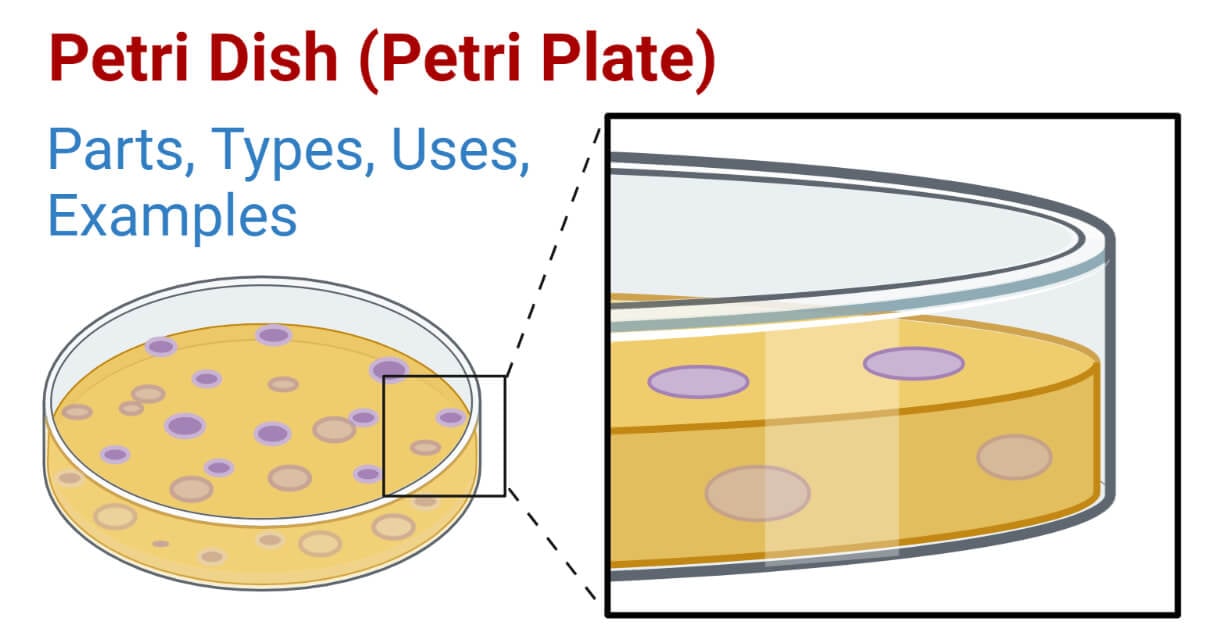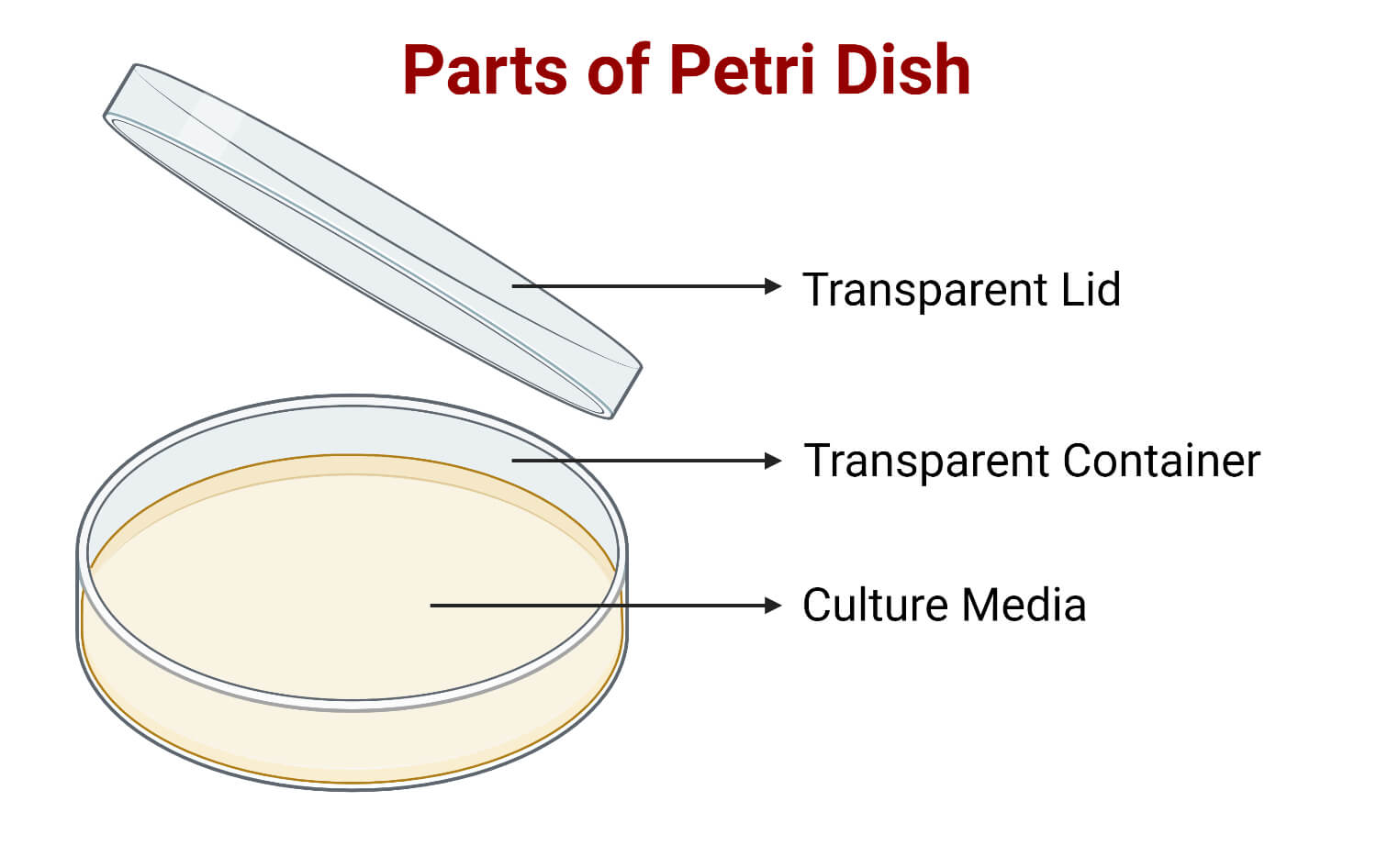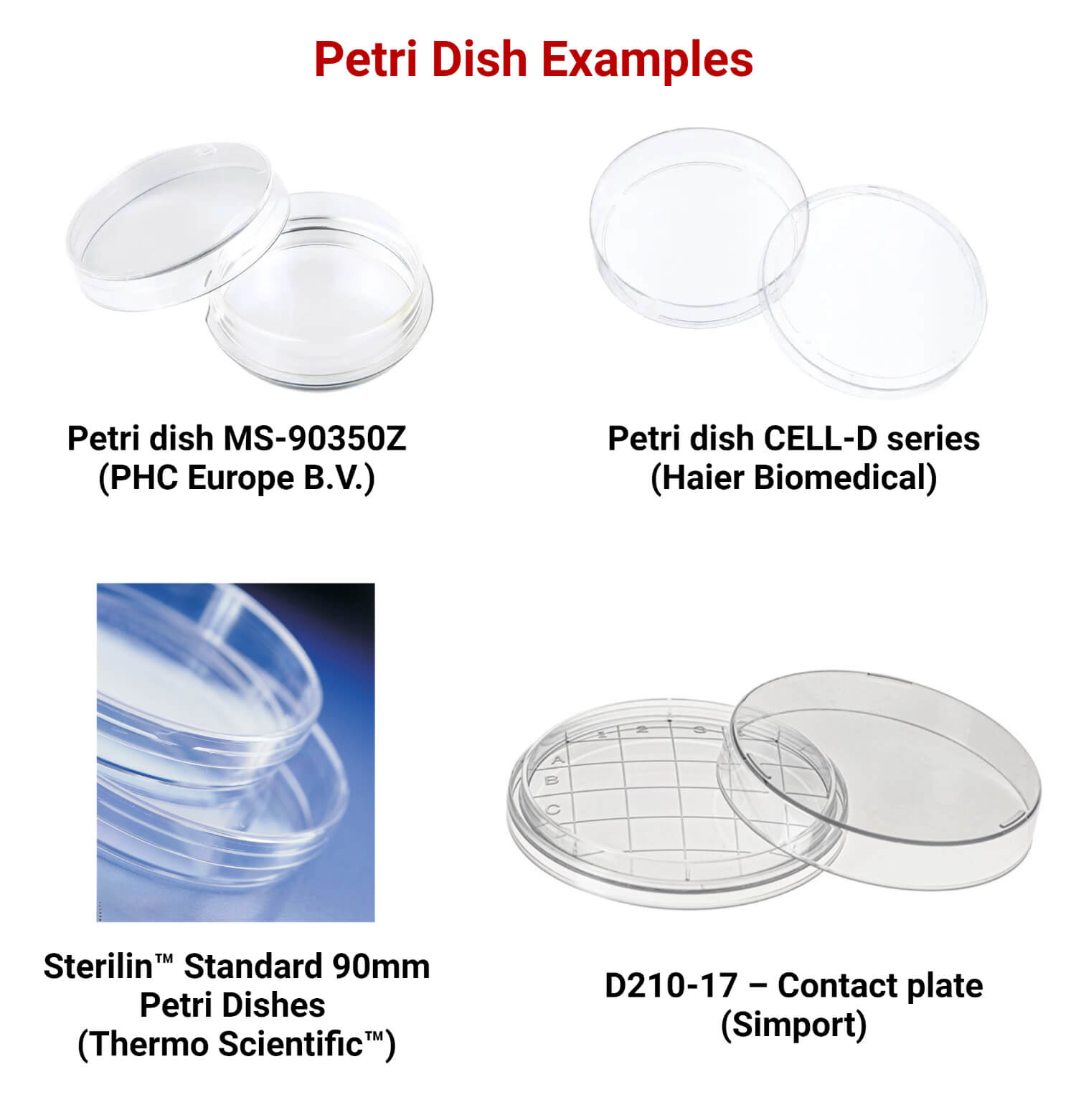A petri dish is a small shallow transparent dish with a lid that is mainly used in biological experiments for the culture of cells.
For instance, in microbiological experiments, a Petri dish is used as a container to grow microbes with growth media in it. It is derived from the name of its inventor, German bacteriologist Julius Richard Petri.
It is also called a Petri plate or culture plate.

Interesting Science Videos
History of Petri Dish
In the 19th century, while working in Koch’s laboratory, German bacteriologist Julius Richar Petri first invented the Petri dish. Petri was working as an assistant to Robert Koch, the renowned German microbiologist. At that time, bacteria used to be cultured in test tubes or flasks with solid media. Hence it was difficult to handle and observe.
Petri solved the problem by improving the old method and creating a shallow, flat dish for easy observation and manipulation of bacterial colonies. In 1887, he published his work “Eine kleine Modification des Kochschen Platten Verfahrens” (A small modification of Koch’s plate method) in which he described the design and uses of such a dish, later known as a Petri dish.
Parts of Petri Dish
The parts of Petri plates include a transparent container with a lid/cover. Normally, parafilm is used to seal the Petri plates. The bottom dish/ container is a larger part that holds the medium and provides a stable base for the plate. It is usually flat with a slightly ridged rim to avoid spillage of agar medium. Labeling with the date, name of the sample, type of medium used, or any other relevant information is done on the bottom dish.

Likewise, the lid/cover is the smaller part of the Petri plate that fits on the top of the bottom dish. It protects the medium from contamination and moisture loss. It is slightly larger than the bottom dish. The lid is also transparent, like the bottom dish, allowing for easy observation of samples inside the dish.
Types of Petri Dish
Based on shape
Usually, Petri dishes are cylindrical, with diameters ranging from 30 to 200 millimeters. Square and rectangular-shaped Petri dishes are also available.
Based on usability
They may be reusable or disposable, depending on the type of materials they are made of. Reusables are durable in the sense that they can withstand repeated dry/wet sterilization procedures.
Based on the type of material
They can be made of glass, polystyrene, polypropylene, or cellulose acetate.
Glass: Borosilicate glass is often used, which is heat resistant and suited for sterilization in autoclaves or even in laboratory ovens at 120-160°C.
Plastic: Plastic petri plates are a good choice if cross-contamination is a problem, as they are disposable. However, they have poor low-temperature performance.
- Polystyrene Petri dishes are disposable and cheap with their wider performance in industrial and clinical settings for routine microbiological testing.
- Polypropylene petri dishes are lightweight, heat and chemical resistant, and more durable than glass Petri dishes.
Cellulose acetate: This type of petri dish is particularly relevant where there is a substantial requirement of oxygen and carbon dioxide, thus facilitating greater gas permeability.
Nitrile petri plates are a good choice for low-temperature applications with a temperature range of -30 F to 275 F.
Based on compartments
Compartments in Petri dishes allow the preparation of multiple culture media in a single plate. The number of compartments may range from 2 to 4.
Applications of Petri Dish
- It is used to culture cells in the storage space present in it. One of the reasons to use this method is also to protect cells from contamination. Also, the transparency of glass/plastic helps to observe the growth of organisms without disturbing them.
- Sometimes, it can also be used in schools and colleges for science projects like the observation of seed germination.
Some petri dishes can be used to measure the density of culture with the help of grids printed on their bottom. - They are used for the storage of samples in liquid or granular form or small objects like insects and seeds.
- They are also used in the evaporation and drying of samples.
One of the common applications of Petri plates is to make agar plates. Here is the simple procedure for making an agar plate:
- Add an appropriate amount of agar with an appropriate volume of distilled water.
- If using nutrient broth or other growth media, add it to the agar mixture and mix.
- Place the flask with the agar mixture in an autoclave for sterilization.
- Carefully remove the flask from the autoclave and allow it to cool to a temperature that is enough to handle but still in a liquid state. Cooling for a longer time might cause the solidification of agar inside the flask.
- Pour the liquid agar mixture into sterile petri plates in the aseptic environment. Agar should be filled to about ¼ or ½ inch depth. After pouring, swirl the plate to distribute the agar uniformly and let it solidify.
- Once the agar is solidified, cover the container with a lid and wrap them with parafilm to avoid drying out and contamination.
- Store the plates in the refrigerator until use.
Advantages of Petri Dish
- It provides the storage space for culturing the cells.
- It also helps to avoid contamination.
- It also comes in different sizes and shapes, which broadens its application.
- The transparent feature of the petri dish helps observe cells inside it without needing to remove the lid.
- Reusability after sterilization is another advantage of using a glass petri dish.
Limitations of Petri Dish
- One of the limitations of using a Petri plate is the need for skilled users. Otherwise, contamination is always a possibility.
- The material used to make Petri dishes is another limitation. Plastic and glass might not be biocompatible or affect experiments dealing with sensitive cells.
- Likewise, it doesn’t mimic the physiological conditions where the cells/microbes grow.
How to use a petri dish in the laboratory?
- After using the dish, treat it with bleach and sterilize it.
- Sterilize the dishes even before using them.
- Store the petri dish in the refrigerator or any storage system upside-down.
Why is the petri dish placed upside down during incubation?
- Evaporation of water takes place on incubation. So, if the Petri plates are placed in a normal position without inverting, the condensation of water from the lid onto the container causes a mix-up of the colony. Therefore, this leads to uneven growth of microorganisms and interferes with determining microbial count.
- Placing the plates upside-down lowers the evaporation rate and prevents media dryness. Thus, a favorable environment for proper microbial growth is created.
- The contaminants are likely to settle on the lid. The placement of the plate in an inverted position reduces the risk of contaminant contact with the culture.
- Easy handling of the inverted Petri dishes.
Precautions
- Sterilization or disposal of Petri dishes should be done before and after their use.
- Gloves should be worn while using Petri dishes.
- Experiments should be performed in a sterile environment.
Petri Dish Examples
Petri dish MS-0350Z (PHC Europe B.V./ PHCbi)
- Ultra-hydrophilic polymers are used to pre-coat the plates that allow spheroid formation.
- High optical clarity in plates facilitates bright field imaging and confocal microscopy.
Petri dish CELL-D series (Haier Biomedical)
- These polystyrene petri plates can be employed for all types of culturing.
- These plates have a flat transparent surface that allows distortion-free observation under the microscope.

Petri dish Sterilin™ (Thermo Scientific)
- Their sizes range from 30 to 140mm and are specifically designed to handle liquid media.
- They are suited for clinical and translational research and help to save incubator space.
Petri dish with counting grid D210-17 (Simport)
- These polystyrene dishes are offered with a grid 10X10 mm grid with numbered and lettered squares, which facilitate counting and locating colonies.
- There are two different models: one with a flat bottom and the other with a convex one.
References
- https://www.scienceequip.com.au/blogs/news/petri-dish-function-and-their-uses-in-laboratory
- https://www.globalspec.com/learnmore/labware_scientific_instruments/labware_consumables/petri_dishes
- https://www.npr.org/2011/12/16/143847287/science-diction-the-origin-of-the-petri-dish
- https://archive.org/details/1887-petri-eine-kleine-modification-des-koch-schen-plattenverfahrens-2020-braus-
- https://microbiologie-clinique.com/petri-dish.html
- https://www.pharmaguideline.com/2015/09/incubation-of-petri-dishes-in-inverted-position.html
- https://www.medicalexpo.com/prod/phc-europe-bv-phcbi/product-70908-1008612.html
- https://www.medicalexpo.com/prod/haier-biomedical/product-299012-1058139.html
- https://www.medicalexpo.com/prod/thermo-scientific/product-78678-591283.html
- https://www.medicalexpo.com/prod/thermo-scientific/product-78678-591283.html
- https://www.medicalexpo.com/prod/simport-scientific/product-70088-1091010.html
